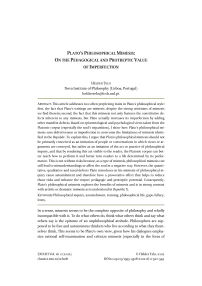Plato’s Philosophical Mimesis: On the Pedagogical and Protreptic Value of Imperfection
Автор: Hélder Telo
Журнал: Schole. Философское антиковедение и классическая традиция @classics-nsu-schole
Рубрика: Статьи
Статья в выпуске: 2 т.16, 2022 года.
Бесплатный доступ
This article addresses two often perplexing traits in Plato’s philosophical style: first, the fact that Plato’s writings are mimetic, despite the strong criticisms of mimesis we find therein; second, the fact that this mimesis not only features the constitutive defects inherent to any mimesis, but Plato actually increases its imperfection by adding other manifest defects. Based on epistemological and psychological views taken from the Platonic corpus (especially the soul’s tripartition), I show how Plato’s philosophical mimesis uses defectiveness or imperfection to overcome the limitations of mimesis identified in the Republic. To explain this, I argue that Plato’s philosophical mimesis should be primarily conceived as an imitation of people or conversations in which views or arguments are conveyed, but rather as an imitation of the act or practice of philosophical inquiry, and that by rendering this act visible to the reader, the Platonic corpus can better teach how to perform it and better turn readers to a life determined by its performance. This is not without risks because, as a type of mimesis, philosophical mimesis can still lead to misunderstandings or affect the soul in a negative way. However, the quantitative, qualitative and tonal defects Plato introduces in his mimesis of philosophical inquiry cause astonishment and therefore have a provocative effect that helps to reduce those risks and enhance the corpus’ pedagogic and protreptic potential. Consequently, Plato’s philosophical mimesis explores the benefits of mimesis and is in strong contrast with artistic or dramatic mimesis as is understood in Republic X.
Philosophical inquiry, astonishment, training, philosophical life, gaps, fallacy, irony
Короткий адрес: https://sciup.org/147237649
IDR: 147237649 | DOI: 10.25205/1995-4328-2022-16-2-520-549
Список литературы Plato’s Philosophical Mimesis: On the Pedagogical and Protreptic Value of Imperfection
- Ausland, H. (1997) “On Reading Plato Mimetically,” The American Journal of Philology 118, 3, 371-416.
- Barney, R. (2016) “What Kind of Theory is the Theory of the Tripartite Soul?” in: Proceedings of the Boston Area Colloquium of Ancient Philosophy, 31, 53-83.
- Blondell, R. (2002) The Play of Character in Plato’s Dialogues. Cambridge: Cambridge University Press.
- Cain, R. B. (2007) The Socratic Method: Plato’s Use of Philosophical Drama. London: Continuum.
- Collins II, J. H. (2015) Exhortations to Philosophy: The Protreptics of Plato, Isocrates, and Aristotle. Oxford: Oxford University Press.
- Plato (1997) Complete Works. Ed. J. M. Cooper and D. S. Hutchinson. Indianapolis / Cambridge: Hackett.
- Frede, M. (1992) “Plato’s Arguments and the Dialogue Form,” Methods of Interpreting Plato and His Dialogues. Ed. J. C. Klagge and N. D. Smith. Oxford: Clarendon Press, 201–220.
- Gaiser, K. (1959) Protreptik und Paränese bei Platon: Untersuchungen zur Form des platonischen Dialogs. Stuttgart: Kohlhammer.
- Gallagher, R. L. (2004) “Protreptic Aims of Plato’s Republic,” Ancient Philosophy 24, 93-319.
- Gonzalez, F. (1998) Dialectic and Dialogue: Plato’s Practice of Philosophical Inquiry. Evanston, IL: Northwestern University Press.
- Gordon, J. (1999) Turning Toward Philosophy: Literary Device and Dramatic Structure in Plato’s Dialogues. University Park, PA: The Pennsylvania State University Press.
- Halliwell, S. (2002) The Aesthetics of Mimesis: Ancient Texts and Modern Problems. Princeton: Princeton University Press.
- Klosko, G. (1983) “Criteria of Fallacy and Sophistry for Use in the Analysis of Platonic Dialogues,” The Classical Quarterly 33, 363-374.
- Kosman, L. A. (1992) “Silence and Imitation in Platonic Dialogues,” Methods of Interpreting Plato and His Dialogues. Ed. J. C. Klagge and N. D. Smith. Oxford: Clarendon Press, 73-92.
- Magrini, J. M. (2018) Plato’s Socrates, Philosophy and Education. Cham: Springer.
- Marshall, M. (2021) Reading Plato’s Dialogues to Enhance Learning and Inquiry: Exploring Socrates’ Use of Protreptic for Student Engagement. New York: Routledge.
- Miller Jr., M. (1986) Plato’s Parmenides: The Conversion of the Soul. Princeton: Princeton University Press.
- Mintz, A. I. (2018) Plato: Images, Aims, and Practices of Education. Cham: Springer.
- Moss, J. (2007) “What Is Imitative Poetry and Why Is It Bad?”, The Cambridge Companion to Plato’s Republic. Ed. G. Ferrari. Cambridge: Cambridge University Press, 415-444.
- Saracco, S. (2017) Plato and Intellectual Development: A New Theoretical Framework Emphasising the Higher-Order Pedagogy of the Platonic Dialogues. Cham: Palgrave Macmillan.
- Scolnicov, S. (1988) Plato’s Metaphysics of Education. London: Routledge.
- Scott, G. A. (2000) Plato’s Socrates as Educator. Albany: State University of New York Press.
- Plato (1999) Clitophon. Ed. S. R. Slings. Cambridge: University Press.
- Sprague, R. (1962) Plato’s Use of Fallacy: A Study of the Euthydemus and Some Other Dialogues. London: Routledge / Kegan Paul.
- Thesleff, H. (2009) “Studies in the Styles of Plato,” Platonic Patterns: A Collection of Studies by Holger Thesleff. Las Vegas: Parmenides Publishing, 1-142.
- Tsouna, V. (2013) “Mimêsis and the Platonic Dialogue,” Rhizomata 1, 1-29.
- West, E. (2000) “Why Doesn’t Plato Speak?”, Who Speaks for Plato? Studies in Platonic Anonimity. Ed. G. Press. Lanham, MD: Rowman & Little Field.
- Woodruff, P. (2015) “Mimesis,” A Companion to Ancient Aesthetics. Ed. P. Destrée and P. Murray. Malden, MA: Wiley Blackwell, 329-340.
- Yunis, H. (2007) “The Protreptic Rhetoric of the Republic,” The Cambridge Companion to Plato’s Republic. Ed. G. R. F. Ferrari. Cambridge: Cambridge University Press, 1-26.


